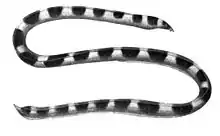Saddled snake-eel
The saddled snake-eel (Leiuranus semicinctus, also known commonly as the halfbanded snake-eel, the banded snake eel, or the culverin[2]) is an eel in the family Ophichthidae (worm/snake eels).[3] It was described by George Tradescant Lay and Edward Turner Bennett in 1839, originally under the genus Ophisurus.[4] It is a marine, tropical eel which is known from the Indo-Pacific and southeastern Atlantic Ocean, including East and South Africa, the Hawaiian Islands, the Marquesan Islands, the Mangaréva islands, Japan, and Australia. It dwells at a depth range of 0 to 70 metres (0 to 230 ft), most often around 0 to 10 metres (0 to 33 ft), and inhabits lagoons and reefs, in which it forms burrows in beds of seagrass and sandy areas. Males can reach a maximum total length of 66 centimetres (2.17 ft).[3]
| Saddled snake-eel | |
|---|---|
 | |
| Scientific classification | |
| Kingdom: | |
| Phylum: | |
| Class: | |
| Order: | |
| Family: | |
| Genus: | |
| Species: | L. semicinctus |
| Binomial name | |
| Leiuranus semicinctus (Lay & Bennett, 1839) | |
| Synonyms[1] | |
| |
The saddled snake-eel's diet consists of fish, crabs, prawns,[3] and worms including Ptychodera.[5] Males and females rise to the surface of the water during spawning.[6]
References
- Synonyms of Leiuranus semicinctus at www.fishbase.org.
- Common names of Leiuranus semicinctus at www.fishbase.org.
- Leiuranus semicinctus at www.fishbase.org.
- Lay, G. T. and E. T. Bennett, 1839 [ref. 2730] Fishes. Pp. 41-75, Pls. 15-23. In: F.W. Bechey (ed.) The zoology of Captain Beechey's voyage, comp. from the collections ... to the Pacific and Behring's Straits... in 1825-28. H. G. Bohn, London.
- Food items reported for Leiuranus semicinctus at www.fishbase.org.
- Reproduction of Leiuranus semicinctus at www.fishbase.org.